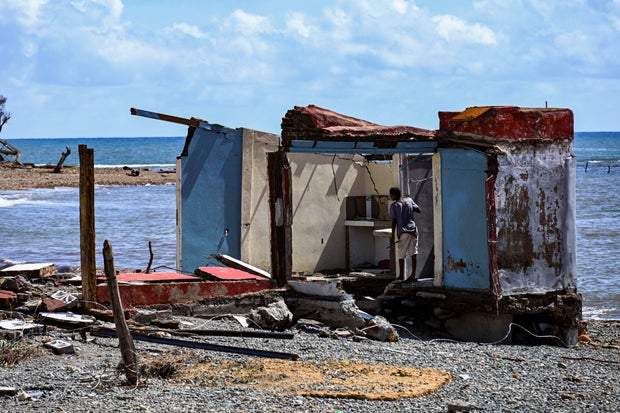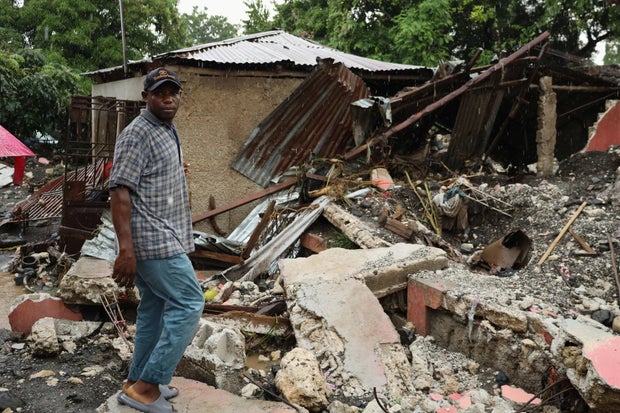The rumble of large machinery, whine of chain saws and chopping of machetes echoed through communities across the northern Caribbean as they dug out from the destruction of Hurricane Melissa and surveyed the damage it left behind.
The storm was being blamed for at least 45 deaths, mostly in Haiti and Jamaica. It also hit Cuba hard.
Authorities said 19 people were killed in Jamaica, at least 25 in Haiti and at least one in the Dominican Republic.
Melissa was over the open waters of the Atlantic racing toward the Bermuda vicinity early Friday packing 90 mph maximum sustained winds, the Miami-based U.S. National Hurricane Center said. A hurricane warning was in effect for the wealthy British territory.
But the agency said, “Gradual weakening is expected during the next couple of days, and Melissa is expected to become a post-tropical low by tonight.”
In Jamaica, government workers and residents began clearing roads in a push to reach dozens of isolated communities in the island’s southeast that sustained a direct hit from one of the most powerful Atlantic hurricanes on record.
Matias Delacroix / AP
Stunned residents wandered about, some staring at their roofless homes and waterlogged belongings strewn around them.
“I don’t have a house now,” said Sylvester Guthrie, a resident of Lacovia in the southern parish of St. Elizabeth, as he held onto his bicycle, the only possession of value left after the storm.
Emergency relief flights were landing at Jamaica’s main international airport as crews distributed water, medicine and other basic supplies. Helicopters dropped food as they thrummed above communities where the storm flattened homes, wiped out roads and destroyed bridges, cutting them off from assistance.
“The entire Jamaica is really broken because of what has happened,” Education Minister Dana Morris Dixon said.
Officials said the dead in Jamaica included a child, and they expected the death toll to keep rising. In one isolated community, residents pleaded with officials to remove the body of a victim tangled in a tree. On Thursday, dozens of U.S. search-and-rescue experts landed in Jamaica along with their dogs.
More than 13,000 people remained crowded into shelters, with 72% of the island without power and only 35% of mobile phone sites operational, officials said. People clutched cash as they formed long lines at the few gas stations and supermarkets open in affected areas.
“We understand the frustration, we understand your anxiety, but we ask for your patience,” said Daryl Vaz, Jamaica’s telecommunications and energy minister.
Water trucks were mobilized to serve many of Jamaica’s rural communities that aren’t connected to the government’s utility system, Water Minister Matthew Samuda said.
No reported deaths but Cuba far from spared
In Cuba, heavy equipment began to clear blocked roads and highways and the military helped rescue people trapped in isolated communities and at risk from landslides.
No deaths were reported after the Civil Defense evacuated more than 735,000 people across eastern Cuba ahead of the storm. Residents were slowly starting to return home Thursday.
YAMIL LAGE / AFP via Getty Images
The town of El Cobre in the eastern province of Santiago de Cuba was one of the hardest hit. Home to some 7,000 people, it is also the site of the Basilica of Our Lady of Charity, the patron saint of Cuba who is deeply venerated by Catholics and practitioners of Santería, an Afro-Cuban religion.
“We went through this very badly. So much wind, so much wind. Zinc roofs were torn off. Some houses completely collapsed. It was a disaster,” said Odalys Ojeda, a 61-year-old retiree, as she looked up at the sky from her living room where the roof and other parts of the house were torn away.
Even the basilica was hit.
“Here at the sanctuary, the carpentry, stained glass and even the masonry suffered extensive damage,” Father Rogelio Dean Puerta said.
A televised Civil Defense meeting chaired by President Miguel Díaz-Canel didn’t provide an official estimate of the damage. However, officials from the affected provinces – Santiago, Granma, Holguín, Guantánamo, and Las Tunas – reported losses of roofs, power lines and fiber optic telecommunications cables, as well as roads cut off, isolating communities, and heavy losses in banana, cassava and coffee plantations.
Many communities were still without electricity, internet and telephone service because of downed transformers and power lines.
In an unusual statement Thursday, the U.S. State Department said Washington was “ready to assist the Cuban people.” It said the U.S. “is prepared to provide immediate humanitarian assistance directly and through local partners who can deliver it more effectively to those in need.”
The statement didn’t specify how the cooperation would be coordinated or whether contact had been made with the Cuban government, with which it maintains a bitter conflict that includes six decades of economic and financial sanctions.
Haiti reeling
Melissa also unleashed catastrophic flooding in Haiti, where at least 20 people were reported missing, mostly in the country’s southern region. Some 15,000 people also remained in shelters.
“It is a sad moment for the country,” said Laurent Saint-Cyr, president of Haiti’s transitional presidential council.
Egeder Pq Fildor / REUTERS
He said officials expect the death toll to rise and noted that the government was mobilizing resources to search for people and provide emergency relief.
Haiti’s Civil Protection Agency said Hurricane Melissa killed at least 20 people, including 10 children, in Petit-Goâve, where more than 160 homes were damaged and 80 others destroyed.
Steven Guadard said Melissa killed his entire family in Petit-Goâve, including four children ranging in age from 1 month to 8 years.
Michelet Dégange, who has lived in Petit-Goâve for three years, said Melissa left him homeless.
“There is no place to rest the body; we are hungry,” he said. “The authorities don’t think about us. I haven’t closed my eyes since the bad weather began.”
When Melissa came ashore in Jamaica as a Category 5 hurricane with top winds of 185 mph on Tuesday, it tied strength records for Atlantic hurricanes making landfall, both in wind speed and barometric pressure.
Melissa brushed past the southeast Bahamas on Wednesday, forcing officials to evacuate 1,400 people ahead of the storm.


